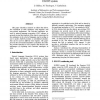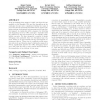OWLED
2008
14 years 1 months ago
2008
The Ontology Web Language (OWL) provides a powerful framework for describing the semantics and constraints of a particular domain described in RDF. Along with that power comes the...
SEMWEB
2004
Springer
14 years 5 months ago
2004
Springer
An analysis of OWL ontologies represented in RDF/XML on the Web shows that a majority are OWL Full. In many cases this may not be through a desire to use the expressivity provided ...
RULEML
2004
Springer
14 years 5 months ago
2004
Springer
Abstract. This paper describes the design and implementation of SweetProlog, a system for translating Web rules into Prolog. It enables the integration of ontologies and rules on t...
SEMWEB
2005
Springer
14 years 5 months ago
2005
Springer
Abstract. After becoming a W3C Recommendation, OWL is becoming increasingly widely accepted and used. However most people still find it difficult to create and use OWL ontologies...
ICTAI
2007
IEEE
14 years 6 months ago
2007
IEEE
This paper introduces ELEON, an editor that allows the enrichment of OWL ontologies with linguistic and user-related annotations. The enriched ontologies are used by natural langu...
CADE
2005
Springer
15 years 18 days ago
2005
Springer
Abstract. We describe the instance store, a system for reasoning about individuals (i.e., instances of classes) in OWL ontologies. By using a hybrid reasoner/database architecture,...
WWW
2005
ACM
15 years 1 months ago
2005
ACM
As an increasingly large number of OWL ontologies become available on the Semantic Web and the descriptions in the ontologies become more complicated, finding the cause of errors ...




